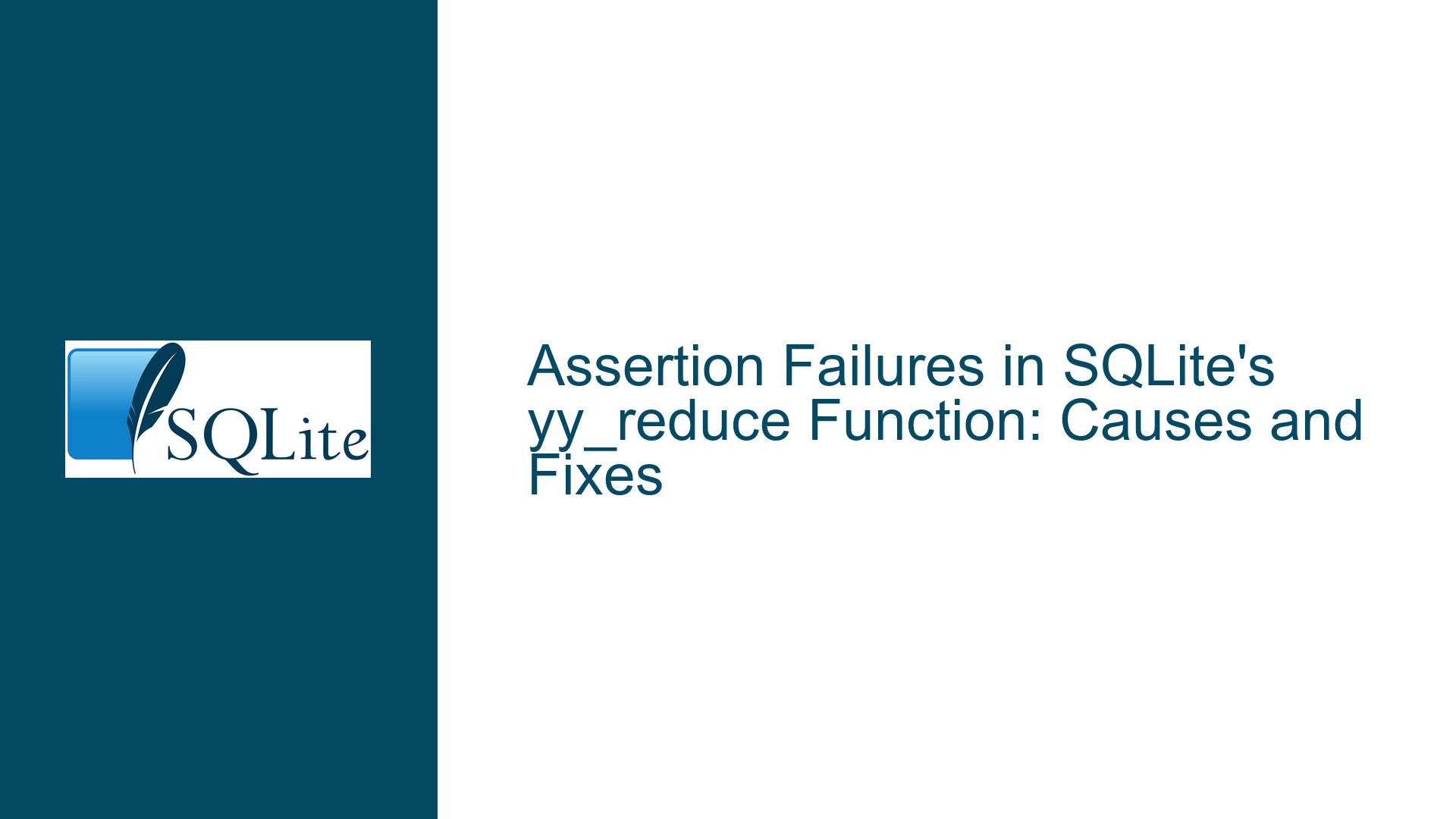Assertion Failures in SQLite’s yy_reduce Function: Causes and Fixes
Understanding the Assertion Failures in SQLite’s Parser
The core issue revolves around assertion failures in SQLite’s yy_reduce function, a critical component of the SQLite parser. These failures occur under specific conditions, often involving memory constraints, syntax errors, or invalid SQL statements. The failures manifest as crashes, segmentation faults, or undefined behavior, making them particularly challenging to diagnose and resolve. Below, we delve into the specifics of these failures, their root causes, and the steps to troubleshoot and fix them.
Root Causes of the Assertion Failures in yy_reduce
The assertion failures in the yy_reduce function are primarily caused by a combination of memory limitations, invalid SQL syntax, and edge cases in the SQLite parser. Let’s break down the contributing factors:
Memory Constraints and Hard Heap Limits
The use ofPRAGMA hard_heap_limit=90000imposes a strict memory limit on SQLite’s operations. This limit is intentionally set low to simulate resource-constrained environments. However, SQLite’s parser and query execution engine require sufficient memory to allocate data structures, parse SQL statements, and manage intermediate results. When the heap limit is exceeded, SQLite fails to allocate memory, leading to assertion failures or crashes.Invalid or Incomplete SQL Syntax
The SQL statements provided in the examples contain syntax errors or incomplete constructs. For instance:CREATE;is an invalid SQL statement because it lacks a table or view definition.CREATE VIEW v AS SELECT * FROM a JOIN;is incomplete due to the missing join condition or table reference.CREATE TRIGGER r DELETE ON t BEGIN SELECT 0;is invalid because the trigger definition is incomplete or malformed.
These syntax errors cause the parser to enter an inconsistent state, triggering assertion failures in theyy_reducefunction.
Parser Edge Cases and Unhandled Scenarios
The SQLite parser is designed to handle a wide range of SQL statements, but certain edge cases can expose vulnerabilities. For example:- The
ALTER TABLEstatement in the example (ALTER TABLE e RENAME TO x;) assumes the existence of tablee, but the parser fails to handle the case where the table does not exist or is invalid. - The
INSERT INTO v VALUES(((0))),(0);statement involves nested parentheses and zero values, which may not be handled correctly under memory constraints.
- The
Undefined Behavior and Segmentation Faults
The use of UndefinedBehaviorSanitizer (UBSAN) reveals that some of these issues result in segmentation faults or undefined behavior. For example, theSELECT * FROM (t) A;statement causes a read access violation at address0x000000000000, indicating that the parser attempted to dereference a null or invalid pointer.Compiler Flags and Debugging Features
The compilation flags used in the examples (-DSQLITE_DEBUG,-DSQLITE_ENABLE_TREETRACE, etc.) enable additional debugging and tracing features in SQLite. While these features are useful for diagnosing issues, they can also expose latent bugs or edge cases that would otherwise go unnoticed.
Troubleshooting Steps, Solutions, and Fixes
To address the assertion failures in the yy_reduce function, follow these detailed troubleshooting steps and solutions:
Validate SQL Syntax and Statements
Ensure that all SQL statements are syntactically correct and complete. For example:- Replace
CREATE;with a validCREATE TABLEorCREATE VIEWstatement. - Complete the
JOINclause inCREATE VIEW v AS SELECT * FROM a JOIN;by specifying the join condition and table reference. - Fix the
CREATE TRIGGERstatement by providing a complete trigger definition, including theFOR EACH ROWclause and a valid trigger action.
- Replace
Adjust Memory Limits and Resource Constraints
Increase thehard_heap_limitto provide sufficient memory for SQLite’s operations. For example:- Use
PRAGMA hard_heap_limit=1048576;to set a 1MB heap limit, which is more realistic for most use cases. - Monitor memory usage using
PRAGMA memory_usage;to identify potential bottlenecks.
- Use
Handle Edge Cases in the Parser
Modify the SQLite parser to handle edge cases and invalid inputs gracefully. For example:- Add checks for null or invalid pointers in the
yy_reducefunction to prevent segmentation faults. - Validate table and column references before executing
ALTER TABLEorINSERTstatements.
- Add checks for null or invalid pointers in the
Apply Patches and Updates
As mentioned in the discussion, some of these issues have been fixed in recent versions of SQLite. Apply the latest patches and updates to benefit from these fixes. For example:- Update to the latest SQLite version or apply the specific patch referenced in the discussion (link).
Use Debugging Tools and Techniques
Leverage debugging tools and techniques to diagnose and resolve assertion failures. For example:- Use
gdborlldbto set breakpoints and inspect the state of the parser when the assertion fails. - Enable additional tracing and logging features using the
SQLITE_DEBUGandSQLITE_ENABLE_WHERETRACEflags to gather more information about the failure.
- Use
Test with Realistic Workloads
Test SQLite with realistic workloads and datasets to identify and address potential issues. For example:- Create a test database with sample tables, views, and triggers.
- Execute a variety of SQL statements, including complex queries and transactions, to ensure that the parser and execution engine handle them correctly.
Review and Refactor Code
Review and refactor the SQLite source code to improve robustness and maintainability. For example:- Identify and remove redundant or unnecessary assertions in the
yy_reducefunction. - Refactor the parser to use more defensive programming techniques, such as validating inputs and handling errors gracefully.
- Identify and remove redundant or unnecessary assertions in the
Engage with the SQLite Community
Engage with the SQLite community to share insights, report issues, and collaborate on solutions. For example:- Post detailed bug reports on the SQLite forum or mailing list, including steps to reproduce the issue and relevant error messages.
- Contribute patches or fixes to the SQLite source code repository.
By following these steps, you can effectively troubleshoot and resolve assertion failures in SQLite’s yy_reduce function, ensuring robust and reliable database operations.






